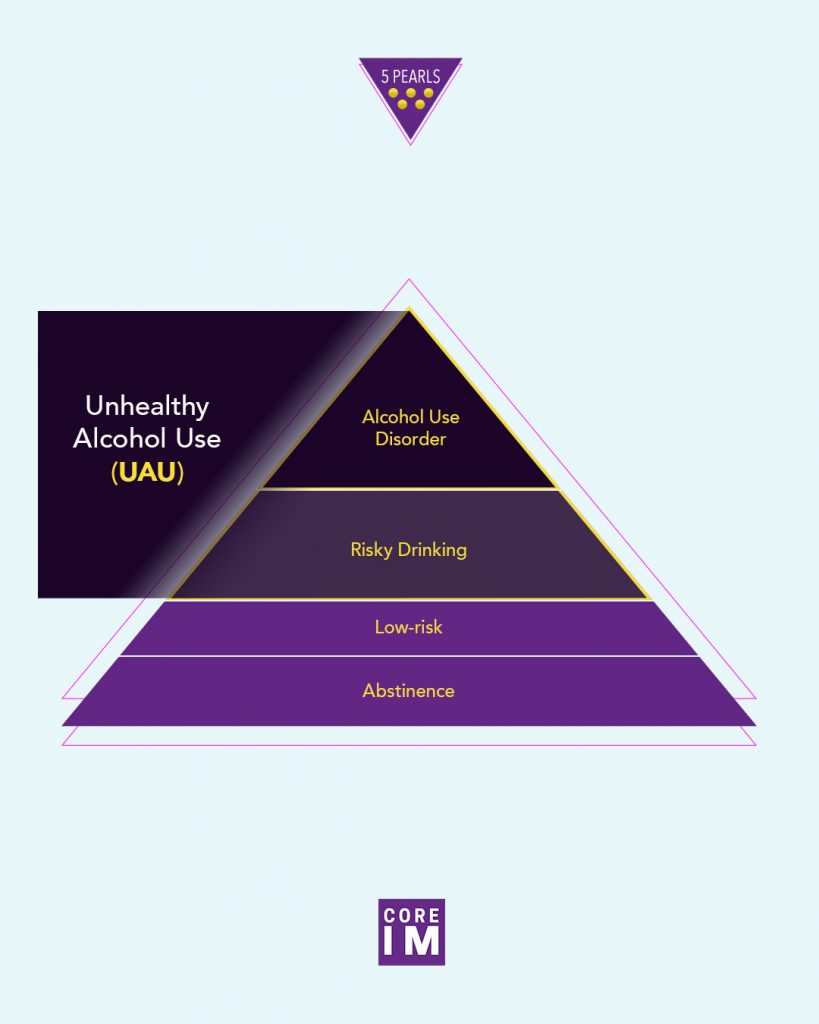Podcast: Play in new window | Download
Subscribe: RSS
 By Kate Lawerence MD, Marty Fried MD, Shreya P. Trivedi MD; Illustration by Ramon Thompson. Quiz yourself on the 5 Pearls we will be covering:
By Kate Lawerence MD, Marty Fried MD, Shreya P. Trivedi MD; Illustration by Ramon Thompson. Quiz yourself on the 5 Pearls we will be covering:
- What is alcohol use disorder (AUD), and how is it different from unhealthy alcohol use? (2:53)
- Who should we screen for unhealthy alcohol use, and which screening tools are preferred? (8:45)
- What are the consequences of unhealthy alcohol use? (14:33)
- Can moderate alcohol be good for patients, and if so, how much is “moderate”? (20:53)
- Pearls Recap (24:29)
- Throwback question: Who, how and how often should patients with chronic hepatitis B infection be screened for hepatocellular carcinoma? (24:29)
Thank you to Dr. John Martin and Dr. Dan Schatz for their help with the script, as well Dr. Jennifer McNeely, an Associate Professor at NYU School of Medicine who specializes in addiction medicine for peer reviewing this podcast!
Subscribe to CORE IM on any podcast app! Follow us on Facebook @Core IM || Twitter @COREIMpodcast || Instagram @core.im.podcast. Please give any feedback at COREIMpodcast@gmail.com.
Show notes
Pearl 1
- Unhealthy alcohol use is a catch-all term meant to describe a spectrum of drinking ranging from risky use all the way to alcohol use disorder.
- The DSM-IV terms alcohol abuse and dependence have been replaced by the DSM-5 term alcohol use disorder, which is defined as a problematic pattern of alcohol use leading to clinically significant impairment or distress, as manifested by psychosocial, behavioral, or physiologic features
- According to National Institute on alcohol Abuse and Alcoholism (NIAAA), risk for alcohol use disorder is thought of as daily and weekly alcohol limits:
- For men less than 65 years: more than 4 drinks/day or 14 drinks/week for
- For women and men over 65 years: more than 3 drinks/day or 7 drinks/week
Pearl 2
- The United States Preventive Services Task Force (USPSTF) has recommended that all adults in primary care be screened for unhealthy alcohol use
- The AUDIT-C tool is the recommended screening tool for unhealthy alcohol use, and consists of the following questions:
- How often did you have a drink containing alcohol in the last year?
- How many drinks containing alcohol did you have on a typical night when you were drinking?
- How often did you have six or more drinks on one occasion in the past year?
- A single-item screening question has also been validated. It is the most sensitive question for unhealthy alcohol use.
- For men, how many times in the last year, have you had more than four drinks in a day?
- For women, how many times in the last year, have you had more than three drinks in a day?
Pearl 3
- The negative health impacts of alcohol include most types of cancer with the exception of thyroid cancer.
- Patients are often diagnosed with comorbid medical conditions that may be reversible if the underlying alcohol use disorder is diagnosed and treated appropriately
- Labs values can be a useful tool for assessing alcohol use and educating patients on end-organ damage; however, they are not recommended for routine diagnosis of the disease
Pearl 4
- Population health research has identified a ‘J-curve’ of potentially beneficial alcohol use, leading to a trend in ‘healthy alcohol use.’ Low levels of alcohol are associated with decreased risks for cardiovascular disease and type 2 diabetes.
- Few medical professionals would recommend ‘healthy drinking’ however; the goal remains moderation or minimal intake.
Pearl 5
- HCC screening is based on risk factors such as family history of HCC, personal history of cirrhosis, ethnicity and sex of the patient with chronic hepatitis B.
- It starts at the time of diagnosis for African patients, age 40 for Asian men, age 50 for Asian women. Also, all patients w/ cirrhosis or a family hx of liver cancer should get routine screening.
- The AASLD recommends HCC screening with liver US every 6 months with or without serum alpha fetoprotein (AFP).
References
- Saitz, Richard. “Unhealthy alcohol use.” New England Journal of Medicine 352.6 (2005): 596-607.
- Diagnostic and Statistical Manual of Mental Disorders, Fifth Edition. https://dsm.psychiatryonline.org/doi/book/10.1176/appi.books.9780890425596
- NIAAA. https://niaaa.nih.gov/
- National Institute on Alcohol Abuse and Alcoholism. Helping patients who drink too much: A clinician’s guide. NIH Publication no. 05-3769, Bethesda, MD 2005.
- Mumenthaler, Martin S.; Taylor, Joy L.; O’Hara, Ruth; Yesavage, Jerome A. Gender Differences in Moderate Drinking Effects. Alcohol Research Vol23 No1 1999.
- USPSTF. https://www.uspreventiveservicestaskforce.org/Page/Document/UpdateSummaryFinal/alcohol-misuse-screening-and-behavioral-counseling-interventions-in-primary-care
- Mertens, Jennifer R., et al. “Physician versus non-physician delivery of alcohol screening, brief intervention and referral to treatment in adult primary care: the ADVISe cluster randomized controlled implementation trial.” Addiction science & clinical practice 10.1 (2015): 26.
- Saunders JB, Aasland OG, Babor TF, et al. Development of the Alcohol Use Disorders Identification Test (AUDIT): WHO Collaborative Project on Early Detection of Persons with Harmful Alcohol Consumption–II. Addiction 1993; 88:791.
- Bush K1, Kivlahan DR, McDonell MB, Fihn SD, Bradley KA. The AUDIT alcohol consumption questions (AUDIT-C): an effective brief screening test for problem drinking. Ambulatory Care Quality Improvement Project (ACQUIP). Alcohol Use Disorders Identification Test. Arch Intern Med. 1998 Sep 14;158(16):1789-95.
- Botros M, Sikaris K. The de ritis ratio: the test of time. Clin Biochem Rev 2013 Nov;34(3):117-30
- International Alliance for Responsible Drinking. Drinking Guidelines General Population. http://www.iard.org/policy-tables/drinking-guidelines-general-population/
- Dufour, M. What is moderate drinking? Defining drinks and drinking levels. Alcohol Res Health. 1999;23(1):5-14. https://www.ncbi.nlm.nih.gov/pubmed/10890793
- Chokshi DA, El-Sayed AM, Stine NW. J-Shaped Curves and Public Health. JAMA. 2015;314(13):1339–1340. doi:10.1001/jama.2015.9566. https://jamanetwork.com/journals/jama/fullarticle/2443580
